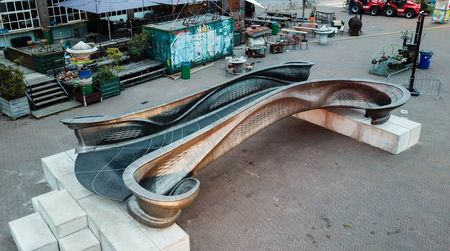Smart Structures for Civil Engineers
by Zachariah Wynne and Dr Thomas Reynolds, Institute of Infrastructure and Environment, University of Edinburgh
The last 100 years have seen a widening disconnect between civil engineers and the structures they create. Historically, those who designed civil infrastructure would either construct, operate, or have a stake in the final structure. Due to the separation of liabilities, the growth of large-scale engineering firms, and the possibilities of remote communication, the modern design process often ends with commissioning, depriving engineers of the chance to learn from the behavior of their structures in-situ.
Smart structures and the Internet of Things (IoT) offers an opportunity to reverse this trend, to adapt designs based on in-service performance of past structures. The MX3D Bridge, shown in Figure 1, is an example of smart infrastructure, being equipped with an array of structural and environmental sensors, from load cells to air quality gauges. These have allowed the structural behavior of this unique structure to be monitored from fabrication to in-service use in Amsterdam, Netherlands.

Figure 1. The MX3D Bridge, a 3D-printed stainless-steel
smart structure, pictured during Dutch Design Week 2019.
Image credit: Gordon Herbert and Craig Buchanan, Imperial College London.
The value of IoT in construction is already estimated at $7.8 billion USD in 2019. Low-cost, easy to install sensors, combined with machine learning, advanced statistics and engineering judgement are already beginning to transform civil engineering.
The civil engineering community has a holistic understanding of infrastructure, which is crucial to that the development of smart structures, the systems which support them, and the applications through which they are accessed. To use IoT data, we must understand what the practicing engineer wants to know, how past projects are currently evaluated, and how structural monitoring is already used across the industry.
The Institute of Infrastructure and Environment at the University of Edinburgh is seeking to guide future research and development of smart structures for the benefit of civil engineers. We are surveying engineers from a broad range of backgrounds on perceptions of uncertainty within civil design, how knowledge of past projects is incorporated in the design process, and how long-term monitoring could improve future civil design.
Where is the uncertainty?
Civil engineering design is driven by debate, from shortfalls or overly conservative design guidance to the interpretation of finite element results. These debates are informed by decades of accumulated knowledge and guidance passed down from previous generations. To improve the safety and efficiency of future designs, it is key that design guidance continues to reflect this wisdom and the knowledge base across the industry. In-service monitoring offers the potential to address these debates, but its implementation must be tailored to do so.
Evaluating success and failure
Civil engineering is a field unlike any other due to the scale and complexity of the final products. It is rare that there is the opportunity to prototype or test structures before they are constructed, so engineers must rely on two core pillars of knowledge; a solid understanding of physics and the distilled knowledge and mistakes of the engineers who came before them.
This knowledge takes the form of both codified design guidance but also that gained from past projects. This can either be informally, through personal experience or discussions with colleagues, or through formal post-project reviews or post-mortems. Long-term monitoring data has the potential to supplement this knowledge if it is properly incorporated into the design process. A world may be imagined where future engineers have not only the wisdom of past engineers to draw on, but the data with which to validate design assumptions. This will be pivotal if the industry is to tackle the challenges of the climate crisis.
Challenges of Big Data
Structural sensing has the possibility to dramatically shift how we design structures. By learning from in-service behavior, we can create more effective and efficient designs, reduce the carbon and economic cost of future structures, extend the lifetime of existing assets and deepen our understanding of the world around us.
However, there are still challenges to be overcome. Who owns the data produced by a structure in-service? At what stage in the design process can it be of use? What liabilities are associated with using data collected by a third party?
We believe that, in order to make sure this technology unlocks safer and more sustainable infrastructure, it must be civil engineers who drive these discussions, not data scientists. In-service monitoring has the potential to transform our understanding of civil structures, allowing us to learn more from past projects and improve the future of the industry.
The survey can be found here. For any questions on and survey, or to find out more about the research, please contact mZ.Wynne@sms.ed.ac.uk.
